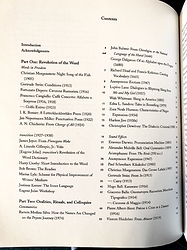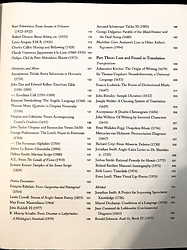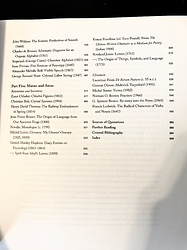Here’s an awesome one that’s one of the last books I bought at a store in the weeks before lockdown:
When works such as “Finnegans Wake” and “Tender Buttons” were first introduced, they went so far beyond prevailing linguistic standards that they were widely considered "unreadable, " if not scandalous. Jed Rasula and Steve McCaffery take these and other examples of twentieth-century avant-garde writing as the starting point for a collection of writings that demonstrates a continuum of creative conjecture on language from antiquity to the present. The result is more laboratory than inventory. The anthology, which spans three millennia, generally bypasses chronology in order to illuminate unexpected congruities between seemingly discordant materials. Thus the juxtaposition of Marcel Duchamp and Jonathan Swift, of Victor Hugo and Easter Island “rongo rongo.”
This was a special find; not only is it like 100% aligned with my interests in experimental writing / language, it’s out of print and copies online start at like $90…I got it for $50 at my favorite neighborhood bookstore and tweeted the following, which captures my stance on “why spend so much on one book” haha:
Anyway, it’s full of all kinds of pieces: on orality and sound, strange fiction, translation theory, alphabet experiments…essays, poetry, lists, images, manifestos…stuff I can’t even describe.
Hard to find much about it online, so here’s the table of contents to get a taste of what I mean! —




